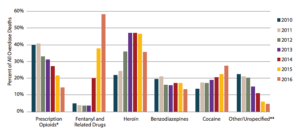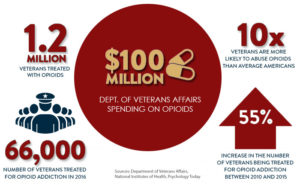KnowOpioids is an initiative with an information portal for identifying, engaging and managing trends in opioids abuse, addiction, epidemic and crisis prevention, treatment and recovery. Under Federal Law the current US administration has declared Public Health Emergency on opioid crisis. KnowOpioids is an initiative to raise awareness to prevent prescription opioid overdoses.
Opioids are highly addictive narcotic substances commonly prescribed to treat unbearable pain. Opioids include prescription medications like morphine, codeine, methadone, oxycodone, hydrocodone, fentanyl, hydromorphone, and buprenorphine, as well as illegal drugs including heroin and illicit potent opioids such as fentanyl analogs (carfentanil).
|
Tolerance develops when someone uses an opioid drug regularly. Our body becomes accustomed and needs a larger or more frequent dose to experience the same effect. Loss of tolerance occurs when someone stops taking an opioid after long term use. When someone loses tolerance and then takes the opioid drug again, our body experiences serious adverse effects, including overdose, even if the amount taken had not caused problems in the past. |
Prescription Opioid Rates in US
All overdose deaths comparison
Growing Opioid Crisis

Common Opioids
|
|
|
|
|
|
|
|

MethadoneDolphin®, Methadone® |
|
Our bodies begin to build a tolerance for opioids, meaning we have to take more to get the same effect. People taking opioids for chronic pain are especially at risk because tolerance continues to grow even after the maximum dose has been reached. Drug tolerance may lead to physical dependency, addiction, abuse, and overdose. Opioids work by binding to specific receptors in the brain, spinal cord, and gastrointestinal tract. In doing so, they diminish the body’s perception of pain. Opioids also have an impact on other systems of the body like altering mood, slowing breathing, and causing constipation. Opioid receptor binding causes the signs and symptoms of overdose as well as the euphoric effects or “high” with opioid use.
 HOW DOES OVERDOSE OCCUR? A variety of effects can occur after a person takes opioids, ranging from pleasure to nausea and vomiting, severe allergic reactions (anaphylaxis), and overdose, in which breathing and heartbeat slow or even stop. Opioid overdose can be due to many factors. For example, overdose can occur when a patient deliberately misuses a prescription, uses an illicit opioid (such as heroin), or uses an opioid contaminated with other even more potent opioids (such as fentanyl). Overdose can also occur when a patient takes an opioid as directed but the prescriber miscalculated the opioid dose, when an error was made by the dispensing pharmacist, or when the patient misunderstood the directions for use. It can also occur when opioids are taken with other medications—for example, prescribed medications such as benzodiazepines or other psychotropic medications that are used in the treatment of mental disorders—or with illicit drugs or alcohol that may have adverse interactions with opioids. Individuals who use opioids and combine them with benzodiazepines, or alcohol/sedative hypnotic agents are at particular risk as it causes respiratory depression.
HOW DOES OVERDOSE OCCUR? A variety of effects can occur after a person takes opioids, ranging from pleasure to nausea and vomiting, severe allergic reactions (anaphylaxis), and overdose, in which breathing and heartbeat slow or even stop. Opioid overdose can be due to many factors. For example, overdose can occur when a patient deliberately misuses a prescription, uses an illicit opioid (such as heroin), or uses an opioid contaminated with other even more potent opioids (such as fentanyl). Overdose can also occur when a patient takes an opioid as directed but the prescriber miscalculated the opioid dose, when an error was made by the dispensing pharmacist, or when the patient misunderstood the directions for use. It can also occur when opioids are taken with other medications—for example, prescribed medications such as benzodiazepines or other psychotropic medications that are used in the treatment of mental disorders—or with illicit drugs or alcohol that may have adverse interactions with opioids. Individuals who use opioids and combine them with benzodiazepines, or alcohol/sedative hypnotic agents are at particular risk as it causes respiratory depression.
WHO IS AT RISK? Anyone who uses opioids for long-term management of chronic pain is at risk for opioid overdose, as are individuals who use heroin or misuse prescription pain relievers. Others at risk include those who:
- Are receiving rotating opioid medication regimens (and thus are at risk for incomplete cross-tolerance).
- Have been discharged from emergency medical care following opioid
- Need opioid pain relievers, coupled with suspected/confirmed substance use disorder or history of non-medical use of prescription opioids or use of illicit
- Have been recently released from incarceration and have a history of opioid use disorder or opioid misuse (and presumably have reduced opioid tolerance and high risk of return to opioid use).
- Have completed opioid detoxification or are abstinent for a period of time (presumably have reduced opioid tolerance, high risk of return to opioid use).
| Opioid Effects & Withdrawal Opioid withdrawal |
Opioid Overdose Signs Treatment Major feature |
|
|
Advisory Board Members

Rajeev Khanna MD
Virginia Medical Arts Clinic
Dr. Rajeev Khanna is Board certified Internal Medicine physician, in private group practice, focused on providing healthcare to the Adult and Senior population of Northern Virginia. He has been in pactice with Dr Chawla since 1999.

Gaurav Bhatia MD
Town Center Orthopedic Associates
Dr. Bhatia is a Harvard trained board certified pain management physician and anesthesiologist. He specializes in treating patients with spine related back and neck pain disorders, and has extensive training in treating patients with chronic pain conditions.

Nick Appolonia CMIO
HIT Group
Nicholas Appolonia is a systems integrator with HIT Consulting; (HIT GROUP) a seasoned Chief Medical Information Officer (CMIO), clinical informaticist, nurse practitioner, clinician in surgical medicine as a first assistant and Subject Matter Expert (SME).

Nipun Aggarwal MD
Dhyanguru
Dr. Nipun Aggarwal is an Internal Medicine physician, Motivational Speaker, Hypnotherapist and an expert in Alternative Medicine with focus on Acupressure & Meditation.










